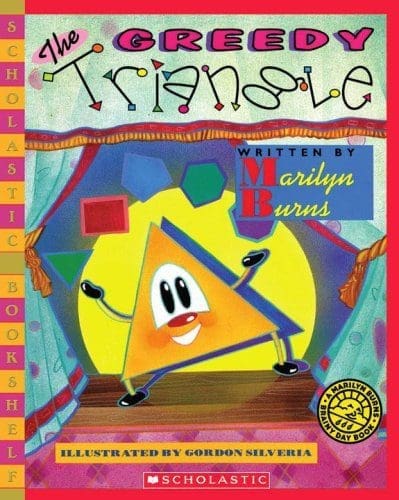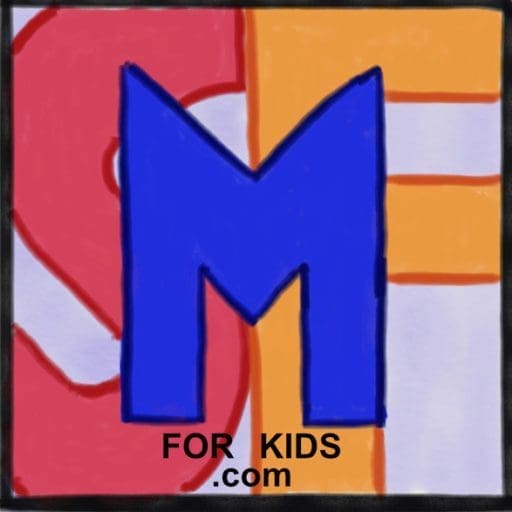
When I think of the best math literature, The Greedy Triangle is at the top of the list. This book is one of those rare books that combines a humorous and engaging story and solid math instruction. I use it to introduce classification of shapes at any level, as well as geometric vocabulary. (It can easily be used for characterization, setting and theme instruction as well.) It has fantastic illustrations of real world examples of each shape. While the official age range on the book is ages 4-8 (preschool-grade 3,) I have read this book with preschoolers all the way up to 6th graders. All have stated it was one of their favorites and increased their level of geometric understanding.
What It’s About
The premise of the story is that the shape always thinks it will be happier if it had “one more side and one more angle.” The triangle goes to visit the shapeshifter who always gives it one more side and one more angle. Eventually the new shape has so many sides that it is almost a circle and rolls down the hill. It decides it would rather be a triangle again.
Teaching Geometric Vocabulary
When I read this book with elementary aged kids, we focus on how prefixes are used to name shapes. “Tri” means 3, “quad” means four, “pent” means 5 etc. I have them think of other words that use those prefixes, or show them examples. We use triominoes and pentominoes as manipulatives so they usually know those and can relate them. I had several GT students who were very interested in using prefixes to name polygons with many more sides. (From them I now know that a triskaidecagon has thirteen sides!) The understanding of quad meaning four is especially important as there are many kinds of quadrilaterals.
Also, it is an important concept of geometry that you always name shapes according to their number of sides. Elementary students can understand that a shape with six sides, for example, is always a hexagon, even if it is an irregular one where the sides are different lengths. Teaching prefixes helps with this. (I love to demonstrate this with ang legs manipulatives.)
Depending on your students’ level, other terms you could teach using this story include: polygon, classify, side, angle, vertex/vertices, as well as all the shape names. With older students you could easily use this book to explore the triangle inequality theorem in a hands on discovery based way.
Flocabulary: Basic Geometry: Shapes
Teaching Attributes of Polygons
I usually give kids craft sticks to make the shapes as we read the story. You could also use geoboards and rubber bands. However, I have found the craft sticks reinforce the concept of adding one more side each time. They also reinforce the idea that curved shapes are not polygons as you can’t use the sticks to make them. (Ang legs manipulatives would also work for this if you have them.) I have had some groups glue the craft sticks forming the shapes, add google eyes and yarn, and make their own puppet show to retell the story. The first group I did this with were kindergarteners and they were able after retelling to identify every shape and its attributes.
Here is a free printable activity sheet for making the shapes with marshmallows and toothpicks.
We also follow the book at any grade level by making a chart of the names of each shape, a picture of the shape, and its number of sides and vertices.
Here is a free Polygon Tree Reference Chart.
10 Ways to Review the Attributes of Geometric Shapes from The Owl Teacher includes ideas for playing Pictionary, Heartbreaker, and Go Fish, making shapes from straws, going on a geometric scavenger hunt, making foldables, and doing a critical thinking sorting activity. It is geared to 3rd grade standards.
Other Ideas for games:
- Shape Concentration- students match the name or attributes of a shape with its picture
- Shape bingo- I call the name of the shape, students mark the picture.
Next Concepts After The Greedy Triangle
There are many ways you could go in following up this book depending on your students’ level and the standards you are teaching. You could sort and classify shapes, look for examples of real world shapes in the classroom or as homework, measure and classify angles, or classify triangles. You could also teach area and perimeter.
Additional Resources
This Scholastic lesson The Greedy Triangle For Every Grade gives relevant common core standards and appropriate activities to use this book with each grade from kindergarten to 5.
In this article from the author of The Greedy Triangle Marilyn Burns’ own site Math Solutions, a 2nd grade teacher described an accordion style prop she made to use while reading the book.
